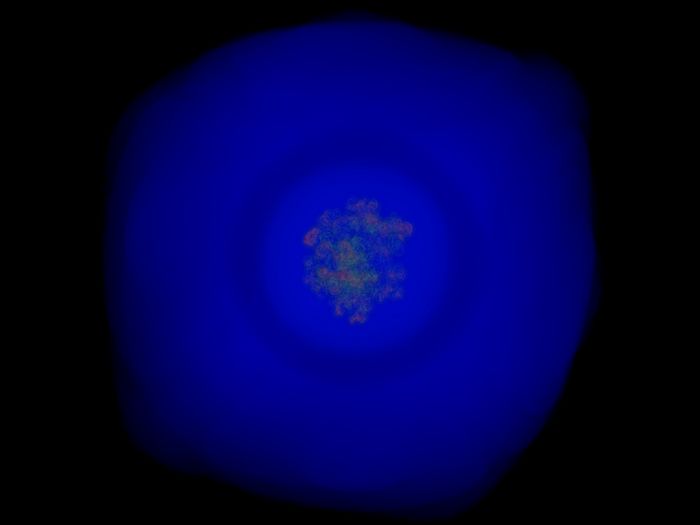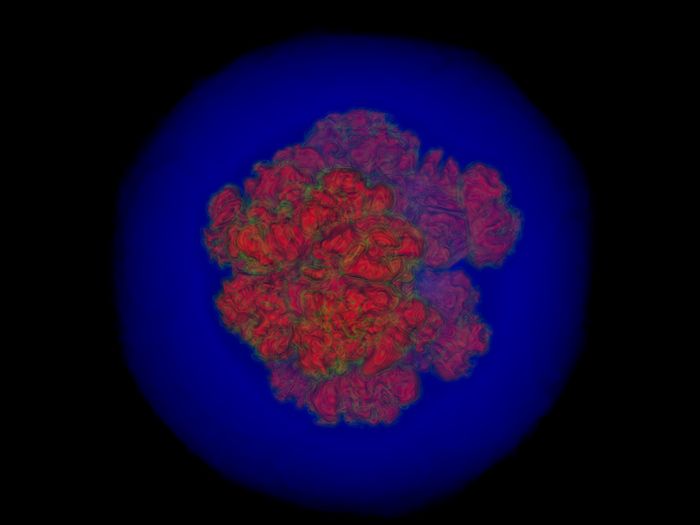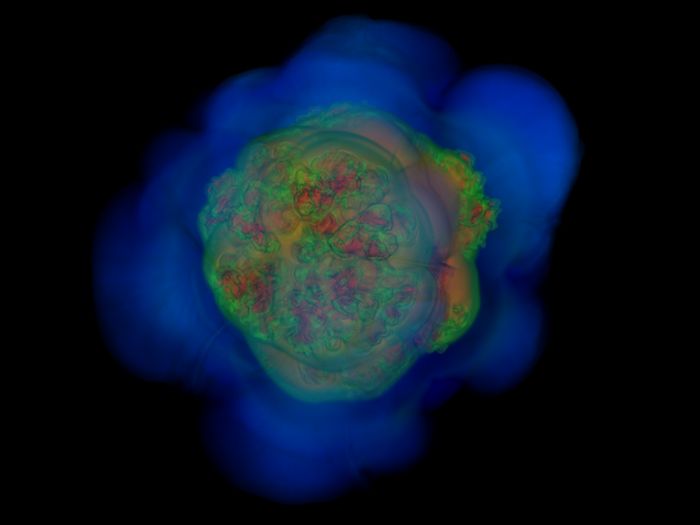ASTROPHYSICS
Exploring the Parameter Space of Thermonuclear Supernovae
Principal Investigator:
Friedrich Röpke
Affiliation:
Universität Würzburg (Germany)
Local Project ID:
hmu13
HPC Platform used:
JUQUEEN of JSC
Date published:
Type Ia supernovae, gigantic astrophysical explosions that completely disrupt one star and shine brighter than an entire galaxy consisting of 100 billion stars, have been successfully used to measure distances in the Universe. But what are the stars that give birth to Type Ia supernovae? The answer to this question remains elusive despite advances in modelling and observing these cosmic events over the past decades. From the perspective of theoretical modelling, only detailed multi-dimensional simulations of the explosion process on the most powerful supercomputers offer a way to tackle this long-standing problem.
Type Ia supernovae, gigantic astrophysical explosions that completely disrupt one star and shine brighter than an entire galaxy consisting of 100 billion stars, have been successfully used to measure distances in the Universe. This work earned the Nobel Prize in Physics in 2011. Moreover, Type Ia supernovae significantly contribute to the chemical evolution of matter in our Galaxy.
But what are the stars that give birth to Type Ia supernovae? The answer to this question remains elusive despite advances in modelling and observing these cosmic events over the past decades. From the perspective of theoretical modelling, only detailed multi-dimensional simulations of the explosion process on the most powerful supercomputers offer a way to tackle this long-standing problem. Although it is generally believed that the exploding star is a so-called white dwarf, a compact object formed at the end of the life of a light star (e.g. similar to our Sun), its detailed properties at the onset of explosion are unknown. The question is how model parameters influence the expected observable results.
This was addressed by an international team of astrophysicists led by Prof. F. Röpke of the University of Würzburg who recently carried out large-scale supernova simulations on the Jülich supercomputers. Such studies enhance our physical understanding of the phenomenon of Type Ia supernovae.
One theoretical model of Type Ia supernovae is that a white dwarf star consisting of carbon and oxygen ignites a thermonuclear explosion when reaching its limit of stability against gravitational collapse - the so-called Chandrasekhar mass. A thermonuclear flame starts at the star's centre and processes its material in nuclear reaction to heavier elements thereby releasing huge amounts of energy and leading to a bright astronomical event.
In the project carried out on Jülich supercomputing systems, an international team of scientists of the University of Würzburg, the Max Planck Institute for Astrophysics in Garching, the Heidelberg Institute for Theoretical Studies, Stockholm University, Queen's University of Belfast and Mount Stromlo Observatory, Australia, collaborated to simulate these explosions. They achieved to establish a modelling pipeline starting with hydrodynamic simulations of the explosion process. By following the details of the involved nuclear reactions and by calculating the emission of radiation, they were able to predict observables from the theoretical explosion model.



The images show the course of the explosion process 0.55 s, 0.97 s, and 1.5 s after explosion. Shown is a volume rendering of the composition: blue corresponds to unburnt material (carbon, oxygen), yellow and green to intermediate mass elements (e.g. silicon, sulfur) and red to iron group elements (e.g. nickel, iron). In this model, first a turbulent deflagration flame rises in plumes to the surface; then, 0.97 s after explosion, a supersonic detonation ignites and burns the rest of the white dwarf. The scales in the images are about 4,000 km, 6,000 km, and 8,000 km.
Copyright: Sebastian Ohlmann (Universität Würzburg, Institut für Theoretische Physik und AstrophysikThese detailed multi-dimensional simulations involve complex physical processes that take place on diverse scales in space and time. Therefore, they are extremely challenging and require substantial computational resources that were provided on the supercomputers JUGENE and JUQUEEN of the Jülich Supercomputing Centre. A series of simulations explored different parameters of the exploding white dwarf star, e.g. the density in its centre and its chemical composition. Correlations between these parameters and observable features could be identified which can be tested against astronomical data to enhance our understanding of the enigmatic initial states of the stars exploding as Type Ia supernovae. Ultimately, one goal is to improve their use in observational cosmology by making distance measurements more precise.
The results of this study are published in the following publication: Sebastian T. Ohlmann, Markus Kromer, Michael Fink, Rüdiger Pakmor, Ivo R. Seitenzahl, Stuart A. Sim, and Friedrich K. Röpke, The White Dwarf’s Carbon Fraction as a Secondary Parameter of Type Ia Supernovae, Astronomy & Astrophysics 572, A57 (2014) (http://dx.doi.org/10.1051/0004-6361/201423924).
Scientific Contact:
Prof. Dr. Friedrich Röpke
Universität Würzburg, Institut für Theoretische Physik und Astrophysik
Campus Hubland Nord
Emil-Fischer-Str. 31, D-97074 Würzburg/Germany
e-mail: friedrich.roepke@astro.uni-wuerzburg.de